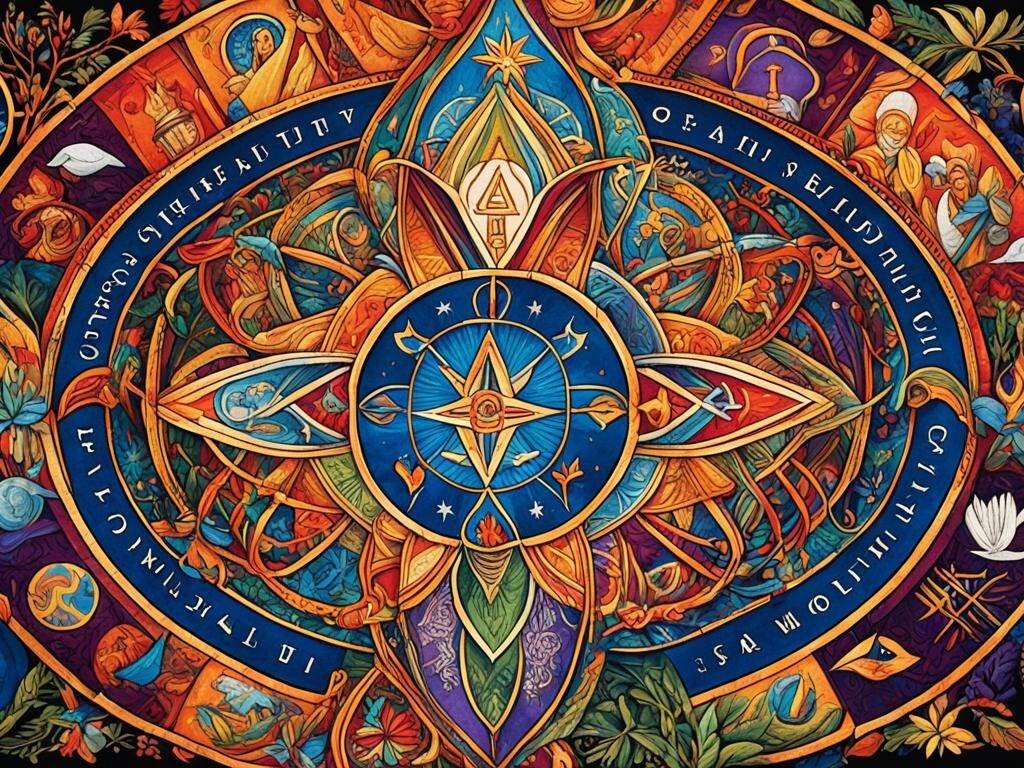Have you ever wondered about the diverse beliefs and practices that shape our world? How do different spiritual and religious traditions contribute to the fabric of our society? Let’s embark on a journey to unravel the mysteries and complexities of religious diversity and pluralism.
Key Takeaways:
- There exists a wide range of different spiritual and religious traditions.
- These traditions encompass unique beliefs, practices, and values.
- Religious diversity plays a vital role in shaping societal perspectives and values.
- Religious pluralism fosters dialogue, understanding, and coexistence among different faith traditions.
- Exploring these traditions can lead to personal growth and a deeper understanding of our world.
Understanding Buddhism
Buddhism, with its emphasis on self-enlightenment and liberation from suffering, is a major spiritual tradition that originated in ancient India. It is founded on the teachings of Siddhartha Gautama, commonly known as the Buddha, who attained enlightenment under the Bodhi tree.
The core principles of Buddhism revolve around the Four Noble Truths, which acknowledge the existence of suffering, its origin in attachment and craving, the possibility of cessation, and the path to achieve liberation from suffering, known as the Eightfold Path.
Meditation and mindfulness are integral practices within Buddhism. Through meditation, practitioners cultivate awareness, concentration, and insight, promoting a deep understanding of the mind and emotions. Mindfulness, on the other hand, involves being fully present in the current moment, observing thoughts, sensations, and experiences without judgment.
“Meditation brings wisdom; lack of meditation leaves ignorance. Know well what leads you forward and what holds you back.” – The Buddha
The teachings of Buddhism extend beyond personal transformation to encompass moral conduct and compassion towards all beings. The ethical principles, encapsulated in the Five Precepts, encourage practitioners to refrain from harming living beings, stealing, engaging in sexual misconduct, speaking falsehoods, and indulging in intoxicants that cloud the mind.
Buddhism also encompasses a diverse range of practices and traditions, including Zen Buddhism, Theravada Buddhism, and Tibetan Buddhism, each with its own unique approaches to meditation, rituals, and cultural expressions.

The Four Noble Truths:
- The truth of suffering (dukkha): Life is characterized by various forms of dissatisfaction and suffering.
- The truth of the origin of suffering (samudaya): Attachment and craving are the root causes of suffering.
- The truth of the cessation of suffering (nirodha): The possibility of liberation from suffering exists by eliminating attachment and craving.
- The truth of the path to the cessation of suffering (magga): The Eightfold Path provides a roadmap to achieve liberation from suffering.
The Eightfold Path:
- Right View
- Right Intention
- Right Speech
- Right Action
- Right Livelihood
- Right Effort
- Right Mindfulness
- Right Concentration
Exploring Hinduism
Hinduism, one of the oldest religious traditions in the world, holds profound significance in the cultural and spiritual landscape of the Indian subcontinent. With its diverse array of religious beliefs and practices, Hinduism offers a rich tapestry of spiritual exploration.
At the core of Hinduism lies a vast pantheon of deities, each representing different aspects of the divine. From Brahman, the ultimate reality, to Vishnu, Shiva, and the goddesses Lakshmi and Durga, Hinduism encompasses a multitude of gods and goddesses. These deities serve as objects of devotion and provide a spiritual framework for followers to connect with the divine.
The sacred texts of Hinduism, including the Vedas, Upanishads, and Bhagavad Gita, serve as guiding principles for religious beliefs and moral values. These texts explore profound philosophical questions and provide insights into the nature of reality and the human experience.
Hinduism also encompasses a diverse range of spiritual practices that enable individuals to cultivate a deeper connection with the divine and attain spiritual growth. Yoga, a practice that integrates physical postures, breath control, and meditation, is an integral part of Hindu spiritual traditions. Through the practice of yoga, individuals seek to achieve physical and mental well-being while attaining spiritual enlightenment.

In addition to yoga, devotion plays a central role in Hindu spiritual practices. Devotees express their love and devotion to the divine through rituals, ceremonies, and prayer. Bhakti, the practice of loving devotion, allows individuals to forge a personal relationship with the deities and experience a profound sense of connection and love.
The intricate tapestry of Hinduism reflects the vastness and complexity of human spirituality. It embraces a multitude of paths and practices, providing individuals with the freedom to explore and find their unique spiritual journey within the framework of Hindu traditions.
Uncovering Christianity
Christianity, one of the most widely practiced religions globally, encompasses a rich tapestry of spiritual practices and deep-rooted religious beliefs. Centered around the life and teachings of Jesus Christ, Christianity offers a framework for believers to connect with their faith and cultivate a relationship with God.
At the core of Christianity are several key tenets that guide the religious beliefs and actions of its followers. These include:
- The belief in the divinity of Jesus Christ: Christians believe that Jesus is the Son of God and that his sacrificial death and resurrection offer salvation to humanity.
- The importance of grace and faith: Central to Christian theology is the concept of grace, which is the unmerited favor and forgiveness of God. Christians believe that they are saved by grace through faith in Jesus Christ.
- The authority of the Bible: The Bible, consisting of the Old and New Testaments, serves as the sacred text of Christianity. It contains teachings, stories, and moral guidance that inform Christian beliefs and practices.
Christianity encompasses a wide range of spiritual practices that vary across different denominations, reflecting the diversity of Christian traditions. These practices often serve as pathways for believers to deepen their connection with God and strengthen their faith. Some common spiritual practices in Christianity include:
- Prayer: Communicating with God through private or communal prayer is a fundamental practice in Christianity.
- Worship: Gathering in churches and other places of worship to participate in praise, worship, and celebration is a cornerstone of Christian spirituality.
- Contemplation: Engaging in quiet reflection, meditation, and contemplation allows Christians to seek spiritual insight and discern God’s guidance.
- Sacrifice and Service: Following the example of Jesus Christ, Christians are called to love and serve others through acts of compassion, selflessness, and generosity.
Additionally, Christianity encompasses various rituals and sacraments that hold significant spiritual meaning for believers. These practices often serve as milestones in a Christian’s journey of faith. Two prominent examples are:
“Baptism: The sacrament of baptism symbolizes a believer’s initiation into the Christian faith and their commitment to follow Jesus. It is a sacred act of purification and rebirth through water.”
“The Eucharist: Also known as Communion or the Lord’s Supper, the Eucharist commemorates Jesus’ last meal with his disciples before his crucifixion. It involves the sharing of bread and wine, which symbolize the body and blood of Christ.”
Christianity is characterized by its diversity, with various denominations and traditions existing within the broader framework of the religion. These denominations may differ in their interpretations of scripture, forms of worship, and organizational structures. Some well-known Christian denominations include:
- Roman Catholicism
- Protestantism
- Eastern Orthodox Christianity
- Lutheranism
- Anglicanism
- Presbyterianism
- Baptist
- Methodism
- Pentecostalism
This diversity within Christianity reflects the complexities and richness of the religion, offering a wide range of spiritual experiences and expressions of faith for its followers.

Christian Denominations Comparison Table
| Denomination | Focused on | Key Beliefs | Worship Style |
|---|---|---|---|
| Roman Catholicism | Papal authority and the sacraments | Transubstantiation, purgatory, Mary’s intercession | Liturgical |
| Protestantism | Individual interpretation of Scripture | Justification by faith, authority of Scripture | Varies (Liturgical to contemporary) |
| Eastern Orthodox Christianity | Tradition and sacraments | Divine mystery, veneration of icons | Liturgical |
Examining Other Faith Traditions
Beyond Buddhism, Hinduism, and Christianity, the global religious landscape is enriched by various other faith traditions. These diverse traditions contribute to the tapestry of religious diversity and provide unique insights into humanity’s spiritual journey. In this section, we will explore some of these lesser-known faiths, shedding light on their distinctive beliefs and practices.
1. Sikhism
Sikhism, founded in the 15th century in the Punjab region of South Asia, emphasizes the importance of selfless service, equality, and devotion to God. Sikhs follow the teachings of Guru Nanak Dev Ji and believe in the existence of one divine creator. The Sikh holy scripture, the Sri Guru Granth Sahib, serves as a guide for spiritual and ethical living.
2. Islam
Islam, one of the world’s major religions, is centered around the teachings of the Prophet Muhammad. Its followers, known as Muslims, believe in the oneness of God (Allah) and strive to live their lives in accordance with the Quran, the holy book of Islam. Islamic practices include daily prayer, fasting during the month of Ramadan, and the pilgrimage to Mecca (Hajj) for those who are able.
3. Judaism
Judaism, one of the oldest monotheistic religions, traces its roots back to ancient Israel. Jewish people follow the teachings of the Torah, which includes the writings and laws found in the Hebrew Bible. Central to Judaism is the belief in the covenant between God and the Jewish people, as well as the observance of rituals and customs such as the Sabbath, circumcision, and Passover.
In exploring these faith traditions, it becomes evident that religious diversity fosters a rich tapestry of perspectives, values, and practices. Interfaith dialogue plays a vital role in promoting understanding, respect, and cooperation among followers of different religions.
4. Bahá’í Faith
The Bahá’í Faith, founded in the mid-19th century, advocates for the unity of all religions, emphasizing the importance of spiritual development, justice, and the oneness of humanity. Followers of the Bahá’í Faith believe in the teachings of Bahá’u’lláh as the latest manifestation of God’s guidance for humankind. Unity, equality, and the elimination of prejudice are core principles of this global faith.
5. Jainism
Jainism, an ancient Indian religion, is rooted in the principles of non-violence, truthfulness, and asceticism. Jains strive to liberate their souls from the cycle of reincarnation by following the teachings of enlightened beings called Tirthankaras. Ahimsa (non-violence) is a fundamental tenet of Jainism, and practitioners follow a strict vegetarian diet and practice meditation and self-discipline.

These are just a few examples of the many other faith traditions that exist across the globe. Exploring and understanding these traditions not only promotes religious diversity but also fosters interfaith dialogue, which is crucial for building bridges between differing beliefs and enhancing mutual respect.
The Role of Religious Beliefs in Society
Religious beliefs hold a profound influence on individuals and society as a whole, shaping values, morals, and norms. The diversity of spiritual and religious traditions provides a myriad of perspectives that foster dialogue, understanding, and the coexistence of different faiths.
Religious diversity is a hallmark of modern society, reflecting the multifaceted nature of human beliefs and experiences. It encompasses various religions, including but not limited to Buddhism, Hinduism, Christianity, Islam, Judaism, and many others. Each tradition brings its unique set of beliefs, rituals, practices, and teachings.
The Impact of Religious Beliefs on Individuals
For individuals, religious beliefs often serve as a guiding compass in navigating life’s challenges and dilemmas. These beliefs provide a framework for moral decision-making, offering a sense of purpose, meaning, and direction. They can offer solace during times of hardship and provide a sense of community and belonging.
blockquote>
“Religious beliefs guide individuals in making ethical choices and navigating life’s complexities.” – Dr. Sophia Patel, Religious Studies Professor
Religious practices such as prayer, meditation, and contemplation are often employed to deepen one’s connection with the divine or to seek inner peace and self-reflection. These practices can contribute to personal growth and spiritual well-being, fostering a sense of interconnectedness with oneself, others, and the world at large.
Promoting Pluralism and Dialogue
Religious diversity encourages dialogue and fosters understanding among different belief systems, promoting religious pluralism. Pluralism recognizes the validity of multiple religious perspectives and emphasizes mutual respect, tolerance, and acceptance. It encourages individuals and communities to engage in interfaith dialogue, finding common ground and celebrating shared values.
Through interfaith dialogue, people from different religious backgrounds can learn from one another, challenging prejudice and stereotypes. It allows for the exploration of theological, philosophical, and ethical questions, promoting cooperation and collaboration on shared societal issues.
“Religious pluralism requires embracing diversity, nurturing dialogue, and aiming for a harmonious coexistence of faith traditions.” – Reverend Michael Thompson, Interfaith Activist
This engagement across religious boundaries helps break down barriers, fostering empathy, empathy, and compassion. It encourages individuals to recognize their shared humanity and work together to create a more inclusive and just society.

The Importance of Religious Beliefs in Society
Religious beliefs not only shape individual attitudes and behaviors but also influence societal norms and values. They play a significant role in moral and ethical frameworks, contributing to the formation of laws, social policies, and cultural practices. Religion has historically provided the foundation for many civilizations, influencing art, literature, music, and architecture.
However, it is crucial to recognize that religious beliefs are not static and can evolve over time. As society progresses, interpretations and understandings of religious texts may change, prompting dialogue and adaptation within faith traditions. This evolution allows religious beliefs to remain relevant in a rapidly changing world while preserving their core values and teachings.
In Closing
Religious beliefs offer guidance, solace, and a sense of community to individuals, while also promoting religious pluralism and fostering dialogue among diverse faith traditions. As we continue to navigate the complexities of a globalized world, embracing religious diversity and understanding the role of religious beliefs in society becomes increasingly important.
Spirituality and Personal Growth
Many individuals seek spirituality as a path to personal growth and self-discovery. Regardless of their specific faith traditions, people across diverse religious backgrounds engage in various spiritual practices that help them deepen their connection with themselves and the world around them.
One of the most common spiritual practices is meditation, which involves quieting the mind and bringing one’s awareness to the present moment. Meditation not only promotes relaxation and stress reduction but also cultivates mindfulness and inner peace. By regularly dedicating time to stillness and introspection, individuals can develop a greater sense of clarity, self-awareness, and emotional balance.
In addition to meditation, contemplative practices like journaling, prayer, and reflection are also instrumental in personal growth. These practices provide individuals with an opportunity to explore their thoughts, emotions, and experiences, allowing for self-expression, healing, and personal transformation.
“Spirituality is about connecting to something greater than ourselves, finding meaning and purpose in life, and continually evolving as individuals.”
Spiritual practices often involve engaging with sacred texts, scriptures, or spiritual teachings that provide guidance and insights. For example, reading passages from the Bible, the Quran, or the Bhagavad Gita can serve as sources of inspiration and contemplation. This engagement with sacred wisdom encourages individuals to reflect on their values, beliefs, and life choices, facilitating personal growth and a deeper understanding of their faith traditions.
Engaging in community rituals and ceremonies is another important aspect of spiritual growth. Through participation in religious services, individuals not only connect with others who share their faith but also strengthen their sense of belonging and connection to a larger spiritual community.
Ultimately, spirituality is a deeply personal journey that is unique to each individual. Regardless of one’s specific faith tradition, the pursuit of spirituality offers a pathway for personal growth, self-discovery, and a greater sense of purpose in life.
Benefits of Spiritual Practices for Personal Growth
Exploring spiritual practices and incorporating them into our daily lives can have numerous benefits for personal growth:
- Enhanced self-awareness and emotional intelligence
- Increased resilience and stress management
- Greater compassion and empathy
- Improved mental clarity and decision-making
- Deepened sense of purpose and meaning
By nurturing our spiritual selves, we can embark on a transformative journey of self-discovery and personal growth, ultimately leading to a more fulfilling and purposeful life.

Overcoming Challenges in Interfaith Dialogue
In a world with diverse religious traditions, fostering interfaith dialogue is both enriching and challenging. Engaging in meaningful conversations across faith boundaries presents both opportunities for growth and barriers that need to be overcome.
Barriers:
- Misconceptions and Stereotypes: Deep-rooted misconceptions and stereotypes about different faith traditions can hinder open and constructive dialogue.
- Fear and Mistrust: Historical conflicts or cultural differences can fuel fear and mistrust, creating barriers to productive conversations.
- Lack of Knowledge: Limited understanding of other faith traditions can prevent individuals from engaging in meaningful interfaith dialogue.
Opportunities:
- Shared Values: Recognizing and highlighting shared values across different faith traditions can build bridges and promote harmonious dialogue.
- Education and Awareness: Increasing education and awareness about religious diversity can promote understanding and empathy.
- Interfaith Events and Initiatives: Organizing interfaith events and initiatives can provide platforms for people of different faiths to come together and exchange perspectives.
Interfaith dialogue is not about conversion; it is about fostering understanding and respect for one another’s beliefs and practices. Through open and compassionate conversations, we can celebrate the beauty of religious diversity and build a more inclusive and harmonious society.
Benefits of Interfaith Dialogue
| Benefits | Explanation |
|---|---|
| Increased Understanding | Interfaith dialogue promotes greater understanding of different faith traditions, beliefs, and practices. |
| Enhanced Empathy | Engaging in dialogue allows individuals to empathize with the experiences and perspectives of others, fostering compassion and respect. |
| Conflict Resolution | Interfaith dialogue offers a platform for resolving conflicts and building peaceful relationships through open communication and negotiation. |
| Promoting Social Cohesion | By fostering mutual respect, interfaith dialogue contributes to the creation of diverse yet cohesive communities. |

Religious Pluralism and Coexistence
Religious pluralism celebrates the coexistence of diverse religious beliefs and faith traditions. It recognizes the beauty and richness of religious diversity, emphasizing the importance of tolerance, acceptance, and mutual respect. In a world where different faiths intersect, it is crucial to foster harmonious relationships and promote understanding.
Religious pluralism encourages individuals and communities to engage in interfaith dialogue, seeking common ground and finding ways to embrace shared values. It recognizes that while religious beliefs may vary, there are often core principles, such as compassion, love, and justice, that transcend individual faith traditions.
By promoting religious pluralism, we create a space where people from different backgrounds can come together, learn from one another, and celebrate the richness of our collective spiritual tapestry. Instead of viewing religious diversity as a source of conflict, we can see it as an opportunity for growth and unity.
“The highest result of education is tolerance.”
– Helen Keller
Religious pluralism invites us to go beyond mere tolerance and cultivate a genuine appreciation for the beliefs and practices of others. It encourages us to challenge our own assumptions and biases, to engage in meaningful discussions, and to build bridges across faith boundaries. In doing so, we not only foster peaceful coexistence but also promote a more compassionate and inclusive world.
The Benefits of Religious Pluralism
Embracing religious pluralism brings a multitude of benefits to individuals and society as a whole:
- Enhanced cultural understanding and empathy
- Strengthened social cohesion and harmony
- Promotion of intellectual exploration and critical thinking
- Encouragement of interfaith collaborations for social change
- Exposure to diverse perspectives and worldviews
Embracing religious diversity allows us to broaden our horizons, challenge our assumptions, and grow personally and spiritually. It provides a platform for interfaith initiatives that work towards common goals, such as environmental stewardship, social justice, and peace-building.
Religious Pluralism in Practice
Religious pluralism is not just a theoretical concept; it is put into practice by organizations, institutions, and individuals around the world. Interfaith dialogue events, workshops, and conferences serve as spaces for open and respectful conversations, where individuals from different faith communities come together to discuss and learn from one another.
One example of religious pluralism in practice is the Parliament of the World’s Religions. This global interfaith gathering brings together representatives from various religious and spiritual traditions to promote dialogue, cooperation, and understanding. Through such initiatives, religious pluralism becomes a lived experience, encouraging people to celebrate their differences and work towards a common vision of a peaceful and inclusive world.
| Benefits of Religious Pluralism |
|---|
| Enhanced cultural understanding and empathy |
| Strengthened social cohesion and harmony |
| Promotion of intellectual exploration and critical thinking |
| Encouragement of interfaith collaborations for social change |
| Exposure to diverse perspectives and worldviews |
The Influence of Spiritual Traditions on Art and Culture
Spiritual traditions have a profound impact on art and culture, shaping the way we express our beliefs and values. From the intricate sculptures of Hindu deities to the serene paintings of Buddhist landscapes, religious traditions inspire and influence artists across the globe.
Artistic Expressions
Art serves as a visual representation of religious narratives, themes, and concepts. It provides a means for individuals to connect with their spirituality and express their devotion. Through various art forms such as paintings, sculptures, architecture, and music, religious traditions come to life.
“Art enables us to transcend the physical and enter the realm of the divine. It allows us to communicate our deepest beliefs and emotions, capturing the essence of our spiritual experiences.”
– Renowned artist, Thomas Kinkade.
Take, for example, the exquisite temples of Angkor Wat in Cambodia, intricately adorned with carvings depicting scenes from Hindu epics like the Mahabharata and Ramayana. These architectural marvels not only serve as sacred spaces but also showcase the artistic brilliance of the builders and the deep reverence for the Hindu traditions.
Symbolism and Ritual
Spiritual traditions often employ symbolism and ritual practices that find their way into works of art. These symbols help convey complex religious concepts and messages that may be difficult to express verbally.
In Christian art, the depiction of the cross is a powerful symbol that represents the sacrifice and redemption of Jesus Christ. Meanwhile, in Buddhist art, the lotus flower is a common motif, symbolizing purity and spiritual awakening.
The Fusion of Art and Culture
Religious traditions not only inspire art but also influence cultural practices and traditions. Festivals, dances, and music often incorporate elements of spirituality, connecting communities and preserving their religious heritage.
For instance, the vibrant Hindu festival of Holi is not only a celebration of the arrival of spring but also a time to honor Lord Krishna. The festival’s colorful powders, lively music, and exuberant dances combine religious devotion with cultural expressions, creating a unique and enriching experience.
Preserving Heritage
Art and culture rooted in religious traditions play a vital role in preserving and passing down cultural heritage to future generations. They serve as a visual and tangible reminder of the beliefs and values that shape communities.
Through art forms like traditional paintings, textiles, and pottery, cultural practices and religious stories are kept alive, ensuring that the wisdom and traditions of the past continue to be cherished and celebrated.
| Religious Tradition | Art Form | Cultural Influence |
|---|---|---|
| Buddhism | Thangka Paintings | Inspired Tibetan art and influenced the cultural aesthetics of the Himalayan region. |
| Hinduism | Kathak Dance | Played a significant role in the development of classical dance forms in India. |
| Christianity | Gothic Architecture | Influenced European architecture and became a symbol of Christian devotion. |
Modern Challenges and Adaptation of Ancient Traditions
In today’s rapidly changing world, traditional spiritual practices and religious traditions face modern challenges that require adaptation and evolution. These ancient traditions, rooted in centuries of wisdom and belief, must find ways to remain relevant and meaningful for a contemporary audience, while still staying true to their core values and teachings.
One of the main challenges these traditions face is the changing cultural and societal landscape. As technology advances and globalization expands, people are exposed to diverse cultures and belief systems, leading to a greater emphasis on individualism and personal spirituality.
Moreover, the fast-paced nature of modern life often leaves little time for deep introspection and spiritual practices. The hustle and bustle of everyday responsibilities can make it difficult for individuals to prioritize their spiritual well-being. As a result, many traditions have had to adapt their practices to fit into the busy schedules of modern-day practitioners.
Another significant challenge is the increasing skepticism and secularism prevalent in society. With advancements in science and technology, some individuals question the relevance and validity of traditional religious beliefs. These challenges have prompted religious traditions to engage in interfaith dialogue and explore ways to bridge the gap between spirituality and science.
Despite these challenges, traditional spiritual practices and religious traditions have shown remarkable resilience and adaptability. They have found innovative ways to reach and engage with new generations, leveraging social media and digital platforms to disseminate their teachings. Additionally, they have incorporated modern elements such as mindfulness practices, cognitive-behavioral techniques, and self-help approaches into their traditional frameworks.
“The traditions of the past need not be confined to the past. By adapting and evolving, they can continue to inspire and transform lives in the present.”
Here is a table showcasing some examples of how different spiritual practices and religious traditions have adapted to modern challenges:
| Spiritual Practice/Tradition | Adaptation |
|---|---|
| Buddhism | Integration of mindfulness in contemporary therapy and mental health practices |
| Hinduism | Promotion of yoga and meditation as holistic approaches to overall well-being |
| Christianity | Utilization of online platforms for virtual worship services and religious education |
| Islam | Development of mobile applications for Quranic study and Islamic prayer reminders |
Overall, the capacity for traditional spiritual practices and religious traditions to adapt and evolve is a testament to their enduring relevance and significance. As the world continues to change, these traditions have shown that they can remain pillars of wisdom and guidance, offering solace and support to individuals seeking spiritual fulfillment in a rapidly evolving society.
Exploring the Intersection of Science and Religion
The intersection of science and religion is a fascinating area of exploration that seeks to understand the relationship between spiritual traditions and religious beliefs on one hand, and scientific advancements on the other. It delves into the ways in which these seemingly different domains interact, converge, and diverge.
In this section, we will analyze how spiritual traditions and religious beliefs have historically influenced scientific thought and vice versa. We will examine the various perspectives and debates surrounding topics such as the origins of the universe, the nature of consciousness, and the ethical implications of scientific discoveries.
Spirituality and Scientific Discoveries
Throughout history, many scientific discoveries have been influenced by religious and spiritual beliefs. For example, the study of astronomy was often motivated by a desire to understand the celestial bodies that were considered divine in various religious traditions. Scientific advancements in fields like medicine and psychology have also been shaped by spiritual practices such as meditation and mindfulness.
At the same time, scientific discoveries have challenged and expanded our understanding of spiritual traditions and religious beliefs. The evolution theory, for instance, has raised questions about creation narratives found in religious texts. The exploration of consciousness through neuroscience has prompted discussions on the nature of the soul and the mind-body connection.
Areas of Convergence and Divergence
While science and religion may appear to be in conflict at times, there are also areas of convergence where they mutually inform and enhance each other. Both aim to uncover universal truths and provide frameworks for understanding the world and our place in it.
“Science without religion is lame, religion without science is blind.” – Albert Einstein
In the field of psychology, for example, the study of mindfulness and its benefits has drawn from both scientific research and ancient contemplative practices. Scientists and theologians have also engaged in fruitful dialogues on topics like the origins of life, morality, and consciousness.
However, there are also areas of divergence where science and religion take different approaches or offer contrasting explanations. The conflict between creationism and evolution is a well-known example, as is the debate over the existence and nature of God. These divergences highlight the complexity and ongoing discussion surrounding the compatibility of scientific and religious perspectives.
The Quest for Understanding
The intersection of science and religion is a topic that invites curiosity, open-mindedness, and respect for diverse perspectives. It encourages us to explore the mysteries of the universe, the nature of existence, and the complexities of human experience.
Through ongoing dialogue and inquiry, we can deepen our understanding of both scientific advancements and religious beliefs, recognizing the value each contributes to our collective knowledge. This exploration can lead to greater appreciation for the intricacies of the human experience and the vastness of the universe.
| Points of Convergence | Points of Divergence |
|---|---|
| Exploration of consciousness | Explanations for the origins of the universe |
| Study of ethics and morality | Concepts of divinity and the nature of God |
| Understanding the interconnectedness of life | Interpretation of religious texts |
Conclusion
In conclusion, the exploration of different spiritual and religious traditions provides us with a profound understanding of the diverse beliefs, practices, and values that exist within the global religious landscape. By delving into the depths of Buddhism, Hinduism, Christianity, and various other faith traditions, we have uncovered the rich tapestry of human spirituality.
Appreciating this diversity is crucial as it fosters interfaith dialogue, promotes religious pluralism, and encourages mutual respect. Through open and meaningful conversations, individuals from different religious backgrounds can come together to share their perspectives, learn from one another, and build bridges of understanding.
Furthermore, embracing the aspects of spirituality and religious practices can contribute to personal growth and self-discovery. Whether it is through meditation, yoga, devotion, or other spiritual disciplines, these practices offer individuals a way to connect with their inner selves and find solace amidst the challenges of life.
Ultimately, our understanding and acceptance of different spiritual and religious traditions can lead to societal harmony. By recognizing the richness and complexity of these faith traditions, we can celebrate religious diversity and work towards a world where individuals from all walks of life can coexist with respect and mutual appreciation.

